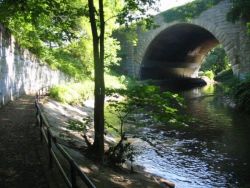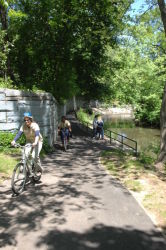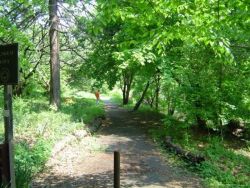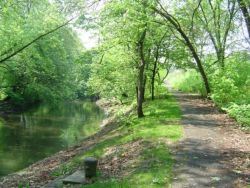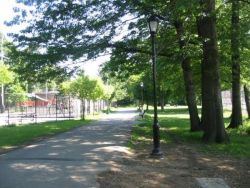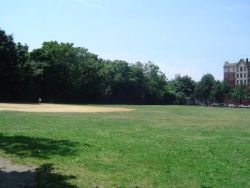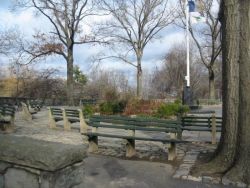Bronx Park
Bronx Park - the Forests of New York City
Although Bronx Park is best known as the site of the Bronx Zoo and New York Botanical Garden, it also contains one of the few natural streamside landscapes remaining in the city. The Bronx River, which begins in North White Plains and flows into the East River at Soundview Park, offers numerous scenic and recreational opportunities and is an ecologically important habitat for diverse species of invertebrates, fish, and birds. The two-mile stretch of river in Bronx Park runs through a deep gorge, where a combination of red maple-hardwood swamp and floodplain forest grows on the riverbanks.
The swamp flourishes in poorly drained depressions, usually on inorganic soils. It can include a broad range of landscapes, including permanently flooded forest and apparent upland forests, which are flooded only a few weeks of the year. Varying mixes of red maple (Acer rubrum), sweetgum (Liquidambar styraciflua), pin oak (Quercus palustris), and tupelo (Nyssa sylvatica) dominate these sites. Floodplain forests grow on mineral soils in the lowlands of river floodplains and deltas. These areas are characterized by their flooding schedule: low areas are annually flooded in spring and high areas are flooded irregularly. Typical floodplain forest tree species include silver maple (Acer saccharinum), white ash (Fraxinus americana), cottonwood (Populus deltoides), black willow (Salix nigra), and American linden (Tilia americana).
A 40-acre forest in the New York Botanical Garden is situated on the slopes above the river gorge. The forest, thought to be the only forest in New York that was never cleared, is a mixture of eastern hemlock (Tsuga canadensis) and hardwoods. The hemlock was once dominant, but, as with hemlocks throughout the Northeast, has since been devastated by an insect pest – the woolly adelgid – that was inadvertently introduced from Asia. In the Bronx River hemlock forest, black cherry (Prunus serotina) and black birch (Betula lenta) are replacing the dying hemlocks.
There were no forests in New York City 15,000 years ago, as a glacier dominated the landscape. As the global climate warmed, the glacier receded and torrents of meltwater carried boulders, gravel, and sand that were deposited in a high ridge marking the southern limit of the glacier’s advance, called a terminal moraine. The dunes and drifts left behind by storms coming off the glacier were early sites of soil formation, providing an opportunity for plant growth.
As grasses, sedges, mosses, lichens, and shrubs began to colonize the area, their roots held the sand in place. Successive generations of dead plant material added organic matter and nutrients to the developing soil. The accumulating soil, with continued warming trends, allowed for the growth of more trees. These trees were widely spaced, and grasses and sedges remained a major component of the vegetation. Kettle ponds formed when huge chunks of ice that had been submerged under soil finally melted and left deep depressions filled with water. Over time, forests took hold of the land.
There are four main layers to a forest: the canopy layer, the understory, the shrub layer, and the ground layer. The canopy layer is made of the tallest trees whose dense, leafy crowns absorb almost all of the sun’s light; sometimes only one percent filters through to the ground. Consequently, other forest plants have to adapt their structure, leaf emergence, and growth behaviors to get the nourishment they need from such a scarce resource. The understory is composed of small trees that can tolerate the lower light levels. Many birds reside here and the flora provides a space between the forest floor and the canopy for such animals as squirrels (Sciuridae), raccoons (Procyon lotor), and opossums (Didelphis marsupialis). The shrub layer can range in height anywhere from knee-high plants to bushes that reach up ten feet or more into the understory. The ground layer is composed of the lowest growing forest plants, the wildflowers and ferns. These plants, which can be as low as a carpeting layer or weeds up to six feet tall, are the first plants to emerge in the spring.
Check out your park's Vital Signs
Clean & Safe
Green & Resilient
Empowered & Engaged Users
Share your feedback or learn more about how this park is part of a
Vital Park System

